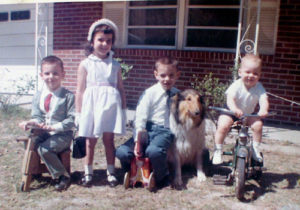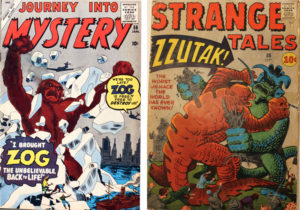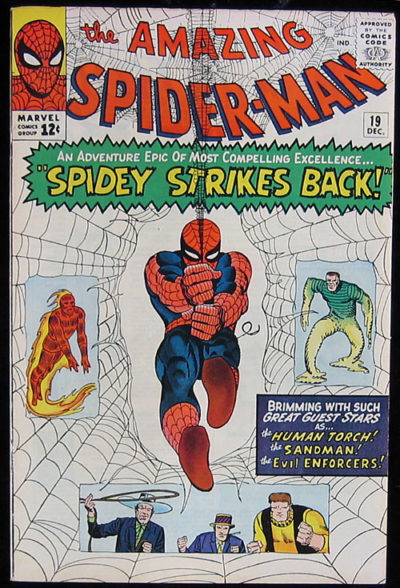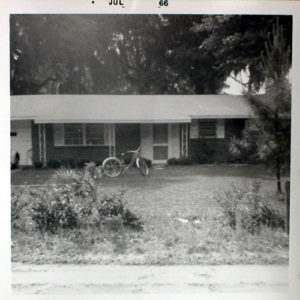
I’m Lewis Forro and I’m the owner of this pedigree Marvel comic book collection. It’s named after the street I lived on in my hometown of Savannah, Georgia back when we Baby Boomers were still living the 1960s, not just remembering them. I want this pedigree collection to more than the usual cryptic annotation in a comic book dealer’s price list, so I’m going to tell you more about it. But first, I want to tell you about how I became a comic book collector. If you’re going to buy an original owner book, it’s nice to know something about the original owner, right?

At age five in 1959 in Elizabethtown Kentucky, I came across my first comic book. I wasn’t old enough to read but I was fascinated with the exciting artwork in one of the stories about giant green dinosaur type monsters chasing astronauts around on the Moon. This story stuck in my memory and several years later while collecting pre-Marvel monster comics I stumbled across it again. The story was “I Planted The Seeds Of Doom” from Journey Into Mystery #56, 1959. The art was by Jack Kirby which explains why I could remember it so vividly for so many years.

My family moved from Kentucky to Savannah, Georgia in 1960 while I was still in the first grade in elementary school. I spent my summers in Tarrant City, Alabama and there’s wher I came across another comic book that had cool looking artwork of giant monsters in it. It had an eye catching cover with a big orange monster fighting a slightly bigger green monster. The green monster had what looked like a blue headdress with an Aztec design which seemed an interesting touch. I had never seen a monster wearing a hat before. Like all previous comics I had this one too was soon lost. Six year old kids aren’t to diligent about saving things I guess. But years later, circa 1966, I lucked into this book again and instantly remembered it. It was Strange Tales #88 from Sep 1961 and the green monster with the blue Aztec top-hat was named Zzutak. Yes, it was another Jack Kirby illustrated monster. I bought this book from a classmate at Bartlett Junior High School on Edgewater Road a few blocks from home. He included it as a bonus with The Amazing Spider-Man #1 from 1963 he sold me for the then substantial sum of $6.00. I’m sure that was the best $6.00 investment I ever made.
In addition to the small handful of these pre-Marvel monster comics I distinctly remember owning a few early regular Marvel superhero comic books which by then I was old enough to read: Fantastic Four #4 from 1962, Incredible Hulk #2 from 1962 and X-Men #3 from 1963. All of these were lost and had to be replaced in later years through mail order comic book dealers. I was to young to have enough attention span to began collecting this early, but the excitement of reading these early Marvels laid the groundwork for later.
In 1964 I had a friend in the neighborhood, Billy Barret, who had about 75 early 1960s DC comic books with Superman and Batman. I didn’t know much about DC but any comic books were of potential interest so I managed to get this friend’s entire stash. I did it by giving him my younger brother’s big green plastic Tyrannosaurus Rex toy, named King Zor that he had gotten for Christmas. My own Christmas present had been a big blue plastic robot, named Robot Commando, but I wanted to keep that. I let my brother read the DC comics I got for the trade which I figured evened everything out. I enjoyed to a modest degree reading these DC comics with their goofy Bizarro Supermen apparently made out of cracked white glass, Lois Lane trying to trick Clark Kent into revealing he was really Superman ad nauseam and all the different flavors of red, green and gold Kryptonite. But these DC books were mundane compared to the Marvels where the artwork seemed to jump off the page and the writing was witty and humorous. So, DC turned out for me to be the road not taken. I was destined to be a Marvel collector.

As good as this Spidey #19 was, I wasn’t attentive enough to keep track of Spider-Man consistently. I picked up Spidey #21, 23 and 30 (all of which I still have) and continued buying a few other Marvels haphazardly throughout 1965. And then something happened. Spider-Man #31 had a really dramatic story that was obviously continued in the next issue. This encouraged me to anticipate and watch for its arrival next month. The long awaited #32 was even better than the #31 and the #33 issue with the climax to this now famous “Master Planner” trilogy was pure dynamite. My earlier sporadic interest instantly congealed into an intense desire to collect all of the mainstream superhero Marvel titles. Heck, I was so smitten with this new found passion I even started collecting the backwater Marvel titles like Sgt. Fury and Rawhide Kid.
Back in the 1960s there were no comic book stores. I lived in the suburbs, not downtown Savannah, so I had no access to any newsstands or book stores that may have been there. One of the very few places in the neighborhood that carried comic books was a 7-11 store on the corner of White Bluff Road and Montgomery Crossroads that intersects Edgewater Road. This 7-11 was owned by a Chinese family named Wu. I remember Mr. Wu had a clock on the wall with the “7” and the “11” in larger numbers than the rest which I thought was clever. He had a long double sided magazine rack in front of the store. The front side that was visible to the outside sidewalk held the normal, respectable magazines. The backside had the adult and other unsavory type magazines. Across from this was a large display wall of smutty adult paperbacks. Kids couldn’t go into this off-limits section but you could get a good glimpse of all this enticing and forbidden stuff while you were perusing the comic book spinner rack that sat nearby.
The 12 or so Marvel comic titles I collected came out every month, usually on two consecutive Wednesdays. I would make my monthly pilgrimage to Mr. Wu’s 7-11 on my red Scwhinn Racer bicycle, eagerly anticipating the lovely Marvels I knew would be waiting for me there. Sometimes the comics were still in their wire wrapped bundles, sitting by the spinner rack where the delivery truck driver had left them. In such cases, I had to wait a few extra seconds for Mr. Wu to cut the wires for me. It was a delicious feeling to be 11 years old in 1965 with enough quarters in your pocket to buy all of the monthly Marvels, and maybe have enough change left over to to buy one of Mr. Wu’s White Lightning Iceys or soft drinks.

In my bedroom across from the foot of the bunkbeads my brother and I had was a small wooden cabinet about three feet high. After gently reading my comics I stacked them in this cabinet. After four years of this routine in late 1968 the cabinet was about full. Also in 1968 Marvel began to increase their monthly output of titles so storage space was becoming a problem. A comic collecting friend, Craig Weatherly, who lived way across town in Windsor Forest mentioned to me he was putting his comic books in his attic for safekeeping. This seemed like a good idea so I took all the books from the cabinet, put them in plastic Baggies in groups of five or six, placed them all in cardboard boxes and squirreled them away in our attic. I talked Dad into building me a set of wooden shelves above the cabinet. From then on I stacked all my newly read comics books on these shelves. Each title had its own stack and I would put the most recent issue on top. Fantastic Four #73 and the other Marvels that came out that month were the first books on the shelves.
In 1970, about the time of Conan The Barbarian #1 and Jack Kirby’s Jimmy Olsen and other DC books, Mr. Wu’s 7-11 went out of business. Another 7-11 soon opened a few blocks away on Montgomery Crossroads on the same side of the street. I continued buying my comics there mostly. In 1969 Oglethorpe Mall opened at the intersection of White Bluff Road and Abercorn Expressway. There was a drugstore there that I used as a backup for comics if the 7-11 missed them. Marvel was putting out more and more books as the 1970s progressed and it was difficult to find all of them. In the mid-1970s a bookstore opened across from the Mall on Abercorn which also carried comics. Even with the 7-11, the drugstore and this new bookstore every so often a book would slip by me, but not to often. I nailed most of them.
In the 1960s Marvel comics were full of fire and lightning. They had the best artists and writers and for my money the freshness and vitality of these comic books has never been equalled since. In 1970 however Marvel’s sparkle began to fade. Steve Ditko and another top artist, Jim Steranko had already left and now the unthinkable happened: Marvel’s flagship artist, Jack Kirby, jumped ship to DC. Then, in 1972 their top writer and editor, Stan Lee, went off to Los Angeles to become a wannabe movie mogul. I remember thinking sadly at the time that Marvel was no longer a small group of talented folks turning out the best comic books on the planet but was becoming a copy of their ancient rival DC; just a big corporate giant flooding the market with mediocre comics. Marvel kept churning out more and more titles but I was becoming less and less interested. I continued buying nearly everything they published but by the late 1970s I was looking for a good excuse to quit collecting comic books.
The excuse came in 1977 when I decided to join the U.S. Air Force. I hadn’t been reading many of the comics I had been buying the last two years or so, just stacking them up. I quit buying nearly everything except Conan which I still liked since Roy Thomas was still writing it. Next, I brought down all the 1965-68 books that had been in the attic for the last nine years. I took them out of the Baggies and put them in new plastic bags from the comic book mail order dealer Robert Bell that I had been doing business with for back issues. Bell was the first person to market speciality comic book bags and had his name and phone number printed on each bag. I also bagged up all the post 1968 comics that were stacked neatly on the two shelves in my bedroom.
As I was doing this I noticed that many of the comics on the shelves from late 1968 through about 1971 had picked up varying degree of foxing stains due to Savannah’s humid weather. In a few cases on certain issues depending on where they sat in the stacks, the foxing was objectionable. In most cases the foxing was very minor. Thankfully, all of the comics from the attic were still immaculately clean since they they had been tucked away in Baggies and boxes and hadn’t been sitting out in the open air. Specialty white comic book boxes hadn’t been invented yet so I put all my comics, about 3200 including pre-1965 mail order back issues, into cardboard liquor and grocery store boxes and stored them in the house, not the attic, so they would stay air conditioned.
I left Savannah in May 1977 when I joined the Air Force. After basic training in Texas and technical school in Denver, Colorado ( where I continued raiding comic book stores for back issues) I was stationed at Mather Air Fore Base in Sacramento, California. I kept buying Conan and The Avengers and maybe a few other books for another year or so but this residual interest was waning fast. By 1980 I was completely done buying new comic books.
I still liked buying high grade duplicates of the early Marvels, the pre-Marvel monster books, EC comics and a few other esoteric books. I went to comic book conventions in San Francisco and San Diego and generally stayed in touch with comic book fandom. I kept reading and hearing about the theory, advanced mostly by Ernie Gerber the recent inventor of Mylar comic book bags, that regular polyethylene and polypropylene plastic bags with their acidic content, could damage comic books over a long period of time. I didn’t want to take any chances with my collection. So, like my earlier decision to put some comics in my attic, I made another vital decision that had long term beneficial consequences. Take a look at the E. Gerber Products ad in Overstreet’s The Comic Book Price Guide #12 from 1981. “Lewis Forro, Savannah” is listed in the Mylar Distributors section that Gerber included in some of his early ads. I wasn’t a distributor, just a collector trying to preserve his books, but it was a logical guess on Ernie’s part. Who else would buy 3,000 4mm Mylar Snugs? I had them mailed to Savannah, took a few days leave and flew home. I put nearly my entire collection into these new fangled and expensive Snugs. Long White acid free comic boxes were available by then and I bought some of them. I tossed out all the cardboard whiskey boxes and Robert Bell bags and stored all 3200 comic books in these Long Boxes vertically, each comic in its own individual Mylar Snug. They’ve been that way ever since, right up to today in The Year Of Our Lord 2004.

You will find it difficult to locate another late Silver Age and Bronze Age comic book collection with documented proof that the books have been stored in archival acid free Mylar since 1981. Mylar was expensive, about 25 cents each for a 4mm Snug even when buying in lots of 1000. Most collectors and dealers only used Mylar for Golden Age or other old expensive comics and kept their Silver Age and Bronze Age books in the far more commonly used plastic bags. Even today, you can go to a comic book convention and find plenty of old comics still being stored in plastic bags instead of Mylar. You can be sure that there wasn’t a lot of collectors in 1981 using Mylar Snugs to store comic books from the late 1960s and 1970s. In the mid-1970s comic books had a cover price of a quarter and using a Mylar Snug that costs a quarter to protect a relatively new comic with a 25 cents cover price would have seemed crazy to most people. I thought it was a little crazy myself but I did it anyway. As a result many of my books today have supernatural cover gloss that will rarely be equalled and never surpassed.
When most collectors and investors buy a rare comic book they have no idea where the book came from, or how many previous owners have handled the book, or how it was stored or how long the cover gloss was being eaten away by plastic storage bags. Even if you buy a “pedigree” book in most cases the pedigree is not documented outside of a dealer’s list and the original owner isn’t known by anybody except the dealer or collector who bought the collection. Here’s a chance to hedge your bets a little by buying a few books from the Edgewater Road Collection. When you do so you know exactly what you are getting and you will be only the second person on Planet Earth to own the book. Aside from the guys at the printing plant who took the books off the press and put the metal wires around the bundles, you will be getting a book touched by only two people: Mr. Wu when he rang up my 12 cents at his 7-11 and me when I read it.


Im a native savannian myself . Been here my whole life. Know all about Edgewater rd. And paradise park. Sounds like you have alot of what im looking for. If your up to it and looking to unload some 60s/70s marvel comics get in touch. Enjoyed your story of coming up / growing up on comics. I use to cut mr. Wu grass in bacon park back in the early/ mid 80s. Bought many a book at the Derenne 7/11 and waters ave Starvin Marvin. Who knows , we could have crossed paths at one time or another. Anyways…..hope to hear from you. Gary……